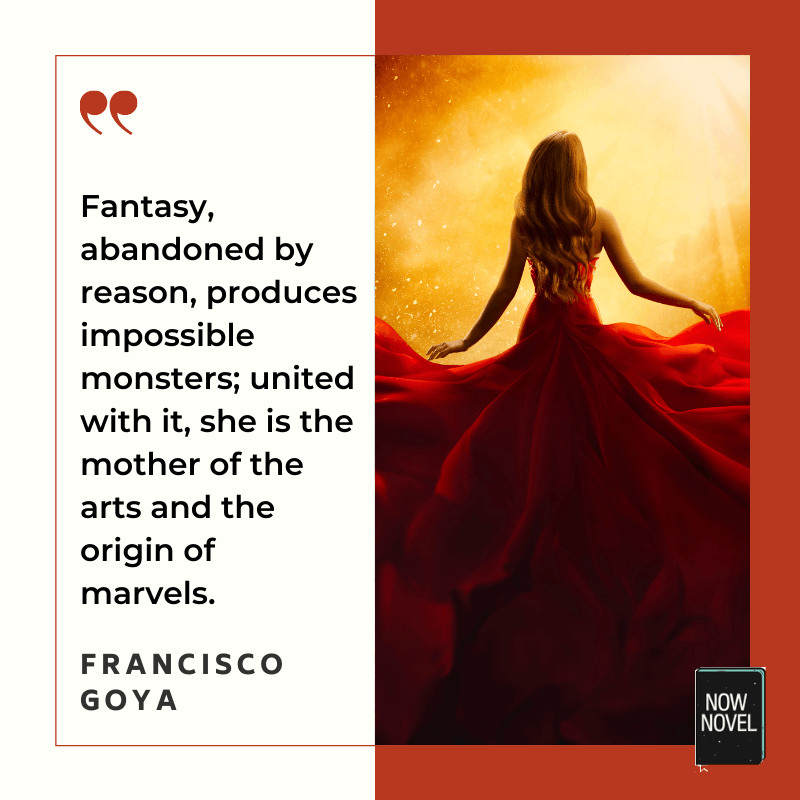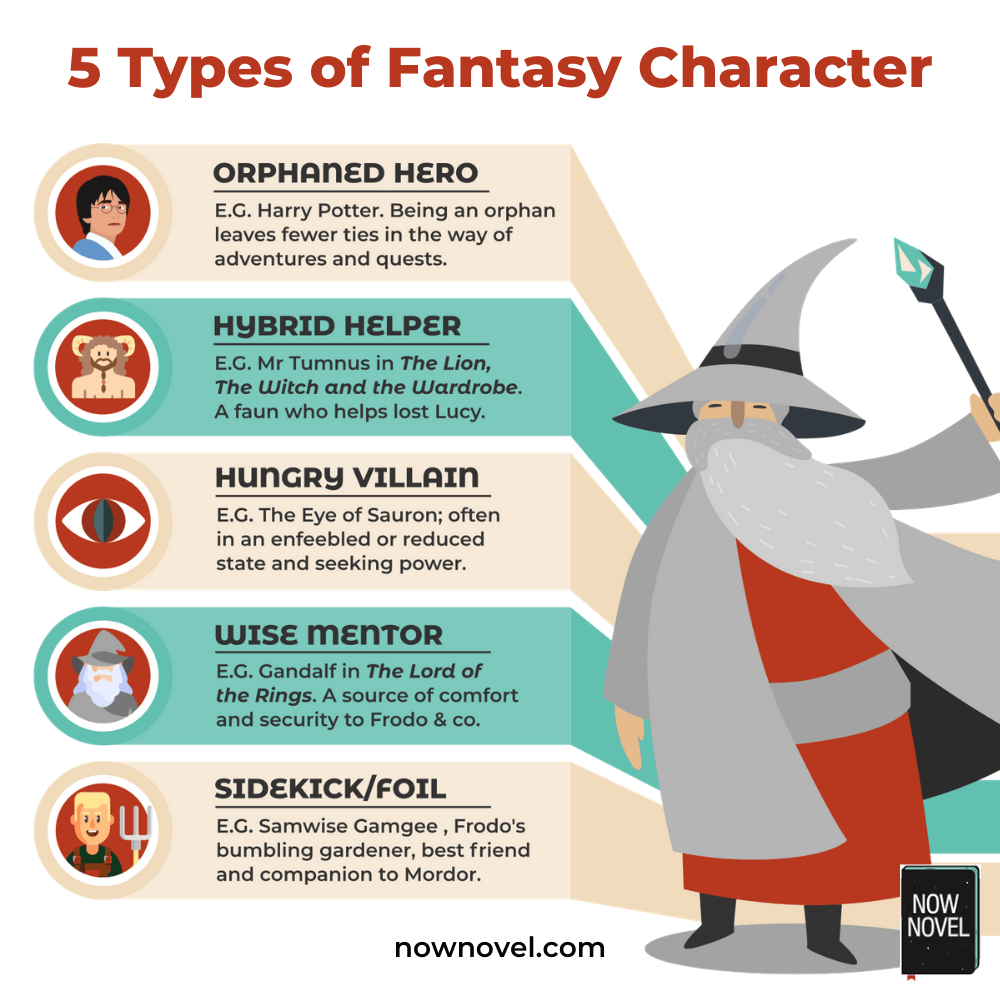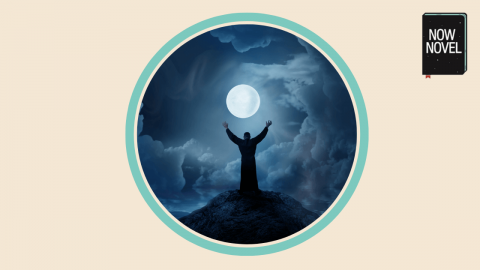Fantasy novels are full of varied fantasy character types. Read about 5 popular types (and ways to avoid associated overdone tropes):
What is a fantasy character type?
When we refer to ‘types’ in fiction, we refer to character molds that recur again and again.
For example, Shakespeares’ plays are full of jesters and kings.
Fantasy is equally full of familiar character varieties.
1. The orphaned hero
The orphaned hero or protagonist is perhaps one of the most troped fantasy characters of all.
You may have thought that J.K. Rowling’s Harry Potter was the first orphan to be whisked off to a world of wizards.
However there is a long tradition for this fantasy character type.
In L. Frank Baum’s The Wonderful Wizard of Oz (1900), famously adapted in 1939 starring Judy Garland, the protagonist is an orphan living with her aunt and uncle on a Kansas prarie.
Frodo Baggins’ parents, of course, were drowned in a boating accident in Tolkien’s iconic fantasy cycle, The Lord of the Rings (1954-1968).
Bookwraiths sums up many of fantasy’s other famous orphans here.
This begs the question: Why so many orphans in fantasy fiction?
Conveniently, an orphan
TV Tropes unpacks some of the benefits of making a character an orphan. An orphan in fantasy:
- Doesn’t need an excuse to ditch family and go adventuring
- May thus obey calls to adventure (because nobody’s at home waiting for visits on Mother’s Day)
- May supply an easy motive tied to a villain (e.g. avenging one’s parents’ death at the hands of said villain)
Given that a character’s orphaned status may seem hackneyed, how do you make orphaned characters interesting?
Tips for writing heroic orphans in fantasy
You may want to avoid the convenient orphan trope altogether.
However, you can avoid the more predictable elements.
May sure your orphaned hero:
- Encounters conflicts based on their current situation: For example, in Harry Potter, Harry’s parents’ death is not the only source of motivation to leave behind his life. His aunt and uncle treat him terribly, creating relevant, present conflict. The orphan trope isn’t as noticeable because other backstory is equally significant.
- Has believable reasons to answer a call to adventure:
Powerful motivations move towards future, uncertain situations. When an orphaned hero is motivated solely by their parents’ death, the potential for future loss, danger or defeat is diminished because the primary conflict driving their actions has already passed.

2. The hybrid helper (or foe)
Fantasy fiction is full of magical helpers.
Dragons and ancient, wise beasts. Talking fauns and solicitous house elves.
Hybrid human/animal types of fantasy character are popular in part because they have a rich tradition in religion, myth and legend.
Think of Medusa, for example, in Ancient Greek legend. A foe with snakes for hair makes a mean aunt or uncle seem quite serene by comparison.
Famous examples of hybrid helpers include:
- Mr Tumnus the Faun in C.S. Lewis’s The Lion, the Witch and the Wardrobe (who helps the protagonist Lucy when she is lost in the land of Narnia)
- Dobby the House Elf in J.K. Rowling’s Harry Potter and the Chamber of Secrets (who brings Harry vital information and later plays a more crucial role)
- Ganesha, one of the deities in the Hindu pantheon typically depicted as having an elephant’s head and a human body. Ganesha is often referred to as a ‘remover of obstacles’
Hybrid characters in fantasy, myth and religion are interesting becuase they suggest:
- The awe and wonder in nature (and in the supernatural)
- How crucial mutual, cross-species care is to our survival (human characters rely on their protection, guidance or other aid)
Writing hybrid types of fantasy characters
When creating a hybrid human/animal character:
- Think about origins: How did this type of being come to exist? Even if the reason borders on silly (Peter Parker being bitten by a radioactive spider leading to spider-like powers), a reason for existence is better than none.
- Look to myth and legend for inspiration: Myths and legends from around the world are fantastic sources of inspiration. Remember to tread carefully (and ask questions) when dealing with other countries’ cultural traditions. Misrepresenting a beloved culture you cannot claim membership of is a recipe for harsh criticism.
3. The hungry villain
Fantasy authors have long delighted in villains who want much more than triple chocolate sundaes. They want total, worldwide control (or destruction), and they want it now.
When writing this fantasy character type, it’s important to establish motivation. Why does a villain so desperately crave this power?
In Sauron’s case in Tolkien’s high fantasy epic, for example, the antagonist has been reduced to a husk of his former power and glory.
Being reunited with the lost ring would restore Sauron’s former might and empire.
This motivation makes sense, because the villain has had a taste of something and it is vastly preferable to their current, enfeebled condition.
There is an inherent sense of cause and effect.
It’s the same kind of cause and effect that underlies various tyrannical forces in history, from the longing for a fabricated folk-based ‘return to roots’ in Hitler’s dark vision to the rise of the caliphate in the power vacuum created in the wake of wars waged in the Middle East.
The above comparisons remind us that every villain has an origin story.
The more we examine their origins, the more we see that tyrants are created by many forces: historical, societal, political, ideological, and so on. That villains may disrupt an era, but are also just as often created by it.
Writing believable fantasy villains
Villains are types of fantasy characters who seldom act alone. A tyrant is nothing without their enablers. As you create a character profile, ask yourself:
- Who props this villain up and why? What do they gain? (Status, wealth, security, some other perk?)
- What is the backstory behind their deeds? How do past events explain their rise to power; and which prior events drive their present motivations?
- What is their flaw? In order for a Sauron, Voldemort, White Witch or other villain to be defeated, they need a fatal flaw.

4. The wise mentor
Buffy has her Watcher, Frodo Baggins has Bilbo and Gandalf, and Luke Skywalker (sci-fi and fantasy are kindred genres) has Obi-Wan Kenobi.
What is a mentor?
The word ‘mentor’ stems from the Greek Mentōr, the name of the adviser of the young Telemachus in Homer’s Odyssey.
Like Telemachus’ trusted advisor, a mentor is crucial to the protagonist’s development.
The main function of a mentor is to educate or train the protagonist. Yet the mentor can bring a powerful emotional component to the story as well.
Take, for example, the school headmaster Dumbledore’s grandfatherly connection to Harry in Harry Potter. Gandalf pillar of strength and comfort in The Lord of the Rings.
Writing strong fantasy mentors
Over the course of a fantasy novel, it is almost inevitable that at some point the mentor and protagonist must part.
Whether this means the death of the mentor or simply the mentor’s temporary departure, this is usually a profound emotional and dramatic turning point.
When writing a mentor-type fantasy character, ask:
- Does the mentor have any unusual abilities such as magical powers to teach, or is their primary purpose to impart non-magical wisdom?
- What is the relationship between the protagonist and the mentor? Is it positive from the beginning, or is it initially a rocky one? Does it have ups and downs? Minor conflicts along the way?
- How do the mentor and protagonist part? Is it sudden and tragic, or is it planned? How does the way the relationship ends affect your protagonist?
5. The sidekick/foil
Among fantasy character types, main characters often seem perpetually heroic.
Sidekicks help to humanize main characters in fantasy.
Think of the bumbling, affable Samwise Gamgee in Tolkien’s The Lord of the Rings, for example.
Samwise’s arc follows his companion’s Frodo’s (in both having to find great personal courage). Yet he is the simpler, less cunning of the two.
Famous fantasy sidekicks include Samwise, Sir Kay in Arthurian legend (Arthur’s rude brother who later pledges allegiance to Arthur when he becomes king), ‘The Luggage’ in Sir Terry Pratchett’s Discworld series, and many more (there’s a great thread on who the greatest fantasy sidekicks are on Reddit, here).
Who are your favourite fantasy characters of all time? Create helpful character profiles for any of the above types in Now Novel’s story dashboard.


6 replies on “Fantasy character types: 5 popular kinds”
Good stuff. Thanks.
Hi Angela,
Thank you! Glad you found it useful 🙂
Thanks for such a nice stuff. Thanks a lot.
It’s a pleasure, Kiran, I’m glad you found it useful.
This post of yours gives a clear sighting to what a layman desires in the books.
I’ve read the kingkiller chronicles and it pretty much has all the descriptions this post has.
Now if I may ask, could you please reccomend me fantasy series like kvith and denna in it and must describe the characters in details like the kkc .
I’ve tried really hard to find one like of but fail to do so ?
This website is awesome!